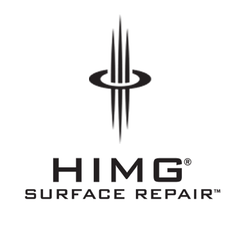Repair Instructions for HIMG® Multi-Color Kit
Multi-Color Kit Repair Instructions with HIMG® Surface Repair Kits
DIRECTIONS
1. Clean the defect and surrounding area so it is free from dust and dirt. Use the included alcohol prep pad to remove any oils or contaminates. Make sure the area is completely dry before proceeding to step 2.
2. Find the polish paste and set it aside. It won’t be used until the end. Then place an applicator tip on each of the Light Cure Acrylic™ syringes. Test for color matching by applying a small drop of each color on the surface next to the defect. At this time you may blend the repair acrylic to achieve a desired tone and volume for your repair. Then using the wooden applicator, scoop the color matched repair acrylic into the damage. For best results, DO NOT OVERFILL. A perfectly filled and cured repair will not require sanding or polishing. We suggest that you make repairs in small sections, no larger than 1/4” or 6mm. Deeper damages will require curing in layers.
3. Place the included curing strip on top of the uncured Light Cure Acrylic™. Using the wooden applicator, gently touch the top of the curing strip to help push the repair material into the damage. If your damage is larger than a curing strip, you can use clear packing tape, folded sticky side to sticky side. Packing tape is also helpful when repairing an edge, used as a retaining wall to hold the repair material in place.
4. Activate the constant on switch on the LED light and use the LED light stand to hold and focus the blue light just above the curing strip.
The Light Cure Acrylic™ will not cure on its own. Exposure duration will depend on the size of the damage, but it is safe to start with 5-7 minutes. Before removing the curing strip, use the wooden applicator to test for hardness. Additional LED exposure may be needed, especially for larger damages. We recommend focusing the LED light in different sections of the damage.
5. Remove the curing strip and verify for a complete cure. If the repair remains tacky after additional LED exposure, you may use rubbing alcohol to gently wipe the repaired surface. Always be extremely careful when sanding softer surfaces like cultured marble or acrylics. Hazing or scratching may occur if you are too aggressive. Next use the yellow 220 grit sandpaper to remove any over filled material. Rub in gentle circles. Then for increased shine, use the included grey 2000 grit wet sanding paper with a dab of water. For best results, sand the repaired area to make it level with the surrounding area.
6. Gently apply a few drops of polishing paste on the repaired area to wipe away dust while polishing the repaired area for maximum shine.
NOTE: It is important to follow each step to ensure an efficient repair and optimal results. If tackiness remains after full curing duration, wipe with rubbing alcohol then sand and polish as directed. We recommend storing syringes with applicator tip installed - gently pull back on the plunger to pull the repair material inside syringe body. Store in a cool dark drawer. LCA™ has a shelf life of 18 months.
For Best Results * It is important to follow each step completely to ensure an efficient repair and optimal results.
* If tackiness remains after full curing duration, wipe with rubbing alcohol or acetone then sand and polish as directed.
